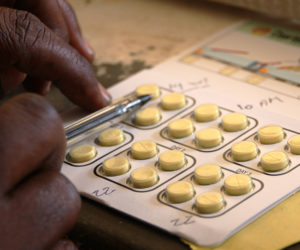Fighting Malaria by Fighting the Counterfeit Medicines
There’s so much good news about malaria – the World Health Organization (WHO) reports notes a 37 percent global decrease in malaria incidence and a 60 percent global decrease in malaria deaths between 2000 and 2015. Case management is improving and behaviors are changing – including prompt care-seeking, testing and treating – all of which have contributed to these declines.
 It is true, however, that many still die from malaria; either they don’t get tested, don’t get treated or die even with treatment. The numbers are still staggering and the threat looks like it will stay around for quite a long time.
It is true, however, that many still die from malaria; either they don’t get tested, don’t get treated or die even with treatment. The numbers are still staggering and the threat looks like it will stay around for quite a long time.
With all of this improvement, even within the greater picture of a stubborn, hard-to-treat disease, there comes a new threat – counterfeit malaria medications, which can negatively affect treatment by simply not healing patients or tragically killing them.
WHO calls them SSFFCs – substandard, spurious, falsified, falsely-labeled and counterfeit malaria medicines. The sale of these counterfeits has other disadvantages aside from harm to patients – it negatively influences consumer behavior, wastes individual and national financial resources and contributes to artemisinin resistance.
The CDC states that counterfeit (fake) and substandard antimalarial drugs may contain no active ingredients, less than the required amount of active ingredients or ingredients not described on the package label. The medication may look and be packaged exactly like what the patient is used to purchasing, but be completely useless if not dangerous.
A counterfeit or substandard treatment can prolong illness and increase the risk of severe disease or death. If substandard medicines are widely used, they can result in drug-resistant parasites.
The scale on which this is happening worldwide is mind-boggling. The British think tank, International Policy Network, estimates 700,000 deaths a year globally are caused by fake malaria and tuberculosis drugs. Most importantly, experts estimate that poor quality malaria medicines may be associated with 122,350 deaths of children under five years old in sub-Saharan Africa (according to a study of 2013 data in 39 countries).
Several global efforts are working on this problem, however few programs are using social and behavior change communication (SBCC) to improve demand for quality malaria medicines and influence behaviors around medicine buying, selling and use.
Since no country is left unsusceptible to this problem, it is critical that SBCC practitioners come together with nontraditional partners to intensify efforts to inform medical professionals, regulators and the general public about the danger of purchasing SSFFC malaria medication for themselves and their families, as well as the steps they can take to protect themselves. The malaria community has come a long way; health practitioners must be thoughtful in how they discuss SSFFC malaria medicines, so as not to create alternate healthcare-seeking behaviors by creating distrust of the effective medicine.
The Health Compass’ latest Trending Topic offers tools and examples to help support program managers and local stakeholders develop effective SBCC strategies to combat counterfeit malaria medicines.
Learn more by registering for:
Please install the The Events Calendar or The Events Calendar Pro Plugin to display a list of upcoming Events







Leave a Reply
Want to join the discussion?Feel free to contribute!